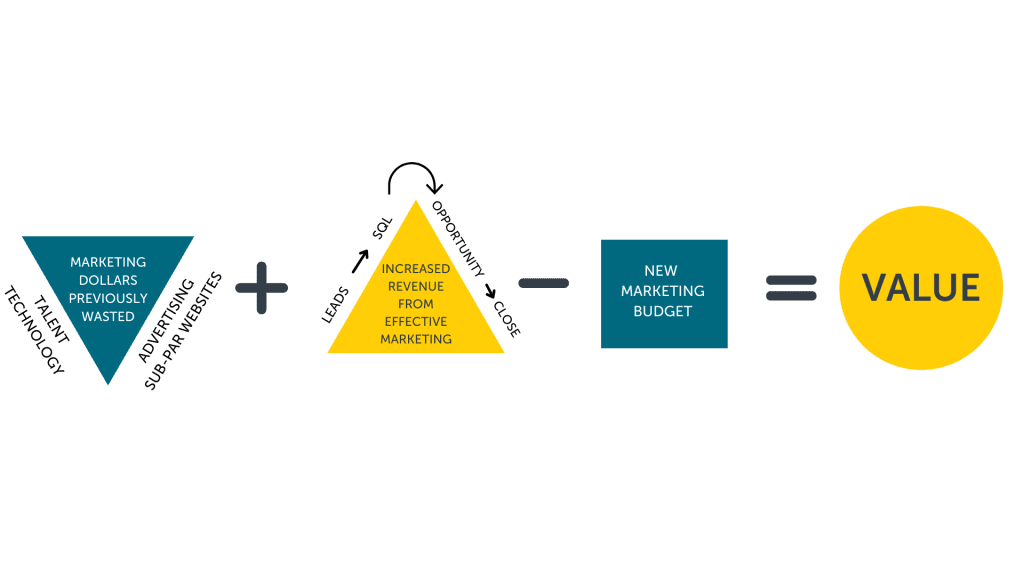What Does a Fractional CMO Cost? A Question Often Asked (& It’s the Wrong One)
Six years ago (March 19, 2015), I wrote a blog post on a little-known marketing position called the fractional CMO. In communicating the value of this new breed of marketer, I shared a common joy:
“Have you ever wandered by a bakery in the mall looking for samples? One perfect, virtually calorie-free bite (or two) can be all it takes to leave you satisfied.”
Portioning is the primary benefit of the fractional CMO. For most small and middle-market companies, a slice of a strategic-thinking, experienced marketer is all they need for positioning, planning, overseeing execution, and analyzing. Multiple slices have diminishing returns and can even hurt a company’s overall program as marketing talent becomes a disproportionate share of a finite marketing budget.
The question becomes: what’s the value of a slice and how much should a fractional CMO cost?
The typical CMO-less marketing model
There are two primary profiles of marketing programs that operate without the expertise of a CMO.
Profile 1: The marketing manager model
A company has a marketing coordinator or manager who takes direction from one or more non-marketing senior-level professionals or the sales team. The result is:
- A lack of strategy or plan
- Scattershot efforts (reactive marketing)
- Marketing role is more or less sales enablement
- Disconnect between marketing and growth objectives
- Unhappy marketing professionals leading to churn
- Lost opportunities to consistently connect with current, past, and prospective customers
A person is not a marketing function especially in these modern marketing times where various skillsets—from content creation to search engine optimization to marketing automation—are needed to effectively compete. This profile seems common with more established, mature companies.
Profile 2: The CEO CMO
The President/CEO of the company is leading the marketing function as one of his/her many responsibilities. Occasionally, this person has some marketing background but it’s not their core expertise and it doesn’t compare to the library of knowledge of a CMO. The result is:
- A strategy but no formal plan (often a list of activities)
- Fragmentation of the marketing function through the hiring of various vendors to do different aspects of marketing (like a puzzle dumped out on a table)
- Hiring and firing of marketing vendors (a bit of a revolving door)
- Marketing expenditures but disappointing results
- “Leading” marketing becomes a major distraction and other aspects of the business get neglected over time
These are the profiles of Marketri’s clients before leadership realizes that what they are doing isn’t working. Financial resources are being wasted. Their company isn’t keeping pace with marketing savvy direct and indirect competitors.
Related: In-house or Outsourced CMO: Which is Right for You?
What’s the value of a fractional CMO?
Let’s get to the question you should be asking if your current marketing model is not delivering results. What is the value of a fractional CMO?
If small and middle-market companies can find the right fractional CMO, the value looks like this:

The value is significant in just stopping the bleeding. When you’re able to layer on measurable results that float to the top line, it’s exponential.
Here’s how much a fractional CMO costs
When evaluating the cost of a fractional CMO, it’s critical to first identify the projected value using the formula above. In that regard, it’s an investment. As a company leader, if you view the hiring of a fractional CMO as a cost, I suggest putting a pause on the process. The pain isn’t yet high enough to view the action as a must-have.
When investing in a fractional CMO, it’s important to view the relationship as longer-term—at least one year. The best professionals will typically only work on a retainer basis and that amount is based upon the amount of time they project to spend with your company to bring value. Hourly rates will vary but they run from $200 – $350 per hour. Plan on your Fractional CMO to spend at least 40 – 60 hours a month to drive change. For many business leaders, the rate is a hard pill to swallow. If taking the pill, however, can bring a positive ROI and stop wasteful spending, it makes good business sense.
Leaders that invest in Fractional CMO services are experiencing great pain around marketing misfires and know they can’t solve the problem alone. The cost of doing the same or nothing is higher than taking a new path forward. They are squarely focused on the value and understand that it comes down to finding the right person or company to partner with.
If you’re interested in learning more about Fractional CMO services, visit Marketri’s blog and/or download our Guide: 5 Questions to Ask When Considering Fractional Marketing






